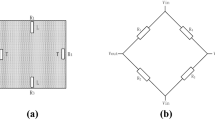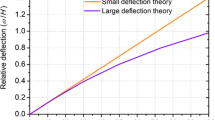Abstract
Temperature drift restricts the measurement accuracy and application fields of high temperature pressure sensors. In this work, a theoretical model of temperature characteristics in SiC piezoresistive pressure sensor was developed to analyze the influence factors of temperature zero drift, including temperature dependence of resistivity and thermal expansion deformation of diaphragm. Then the effect of various size combinations of piezoresistors on the zero-point output of pressure sensors was investigated through the finite element method and an asymmetric Wheatstone bridge was proposed to effectively compensate for temperature zero drift. The size of transverse piezoresistor should be larger than that of longitudinal piezoresistor when the resistances are equal. Finally, the validity of the asymmetric Wheatstone bridge in sensor model with manufacturing errors was further evaluated. The above research results are significant for the structural design and performance optimization of SiC piezoresistive pressure sensors.
Similar content being viewed by others
Data Availability
The data and material in the manuscript will be available to any scientist wishing to use them for non-commercial purposes.
References
Seo Y, Kim D, Hall NA (2020) On-diaphragm thermistor for high temperature dynamic pressure sensors. IEEE Sensors J 20:2287–2293
Yang C, Maimaitiyiming X, Mi H (2019) High temperature sensitivity pressure sensors based on filter paper as a mold. J. Electrochem Soc 166:B1286–B1292
Wijesundara MBJ, Azevedo RG (2011) Silicon carbide microsystems for harsh environments. Springer, New York. 10. 1007/978–1–4419-7121-0
Fahrner WR, Job R, Werner M (2001) Sensors and smart electronics in harsh environment applications. Microsyst Technol 7:138–144
Li C, Zhao L, Ocaña JL, Cordovilla F, Yin Z (2020) Characterization and analysis of a novel structural SOI piezoresistive pressure sensor with high sensitivity and linearity. Microsyst Technol. 26:2955–2960
Okojie RS, Ned AA, Kurtz AD (1998) Operation of a (6H)-SiC pressure sensor at 500 °C. Sens Actuators A Phys 66:200–204
Nguyen TK, Phan HP, Han J, Dinh T, Foisal ARM, Dimitrijev S, Zhu Y, Nguyen NT, Dao DV (2018) Highly sensitive p-type 4H-SiC van der Pauw sensor. RSC Adv 8:3009–3013
Jiang L, Cheung R (2009) A review of silicon carbide development in MEMS applications. Int J Comput Mater Sci Surf Eng 2:227–242. https://doi.org/10.1504/ijcmsse.2009.027484
Wieczorek G, Schellin B, Obermeier E, Fagnani G, Drera L (2007) SiC based pressure sensor for high temperature environments. Proc IEEE Sens Conf. https://doi.org/10.1109/ICSENS.2007.4388508
Lin L, Chu HC, Lu YW (1999) A simulation program for the sensitivity and linearity of piezoresistive pressure sensors. J Microelectromech Syst 8:514–522
Okojie RS, Lukco D, Nguyen V, Savrun E (2015) 4H-SiC piezoresistive pressure sensors at 800 °C with observed sensitivity recovery. IEEE Electron Device Lett 36:174–176
Nguyen TK, Phan HP, Dinh T, Dowling KM, Foisal ARM, Senesky DG, Nguyen NT, Dao DV (2018) Highly sensitive 4H-SiC pressure sensor at cryogenic and elevated temperatures. Mater Des 156:441–445
Akiyama T, Briand D, de Rooij NF (2011) Piezoresistive n-type 4H-SiC pressure sensor with membrane formed by mechanical milling. Proc IEEE Sens Conf. https://doi.org/10.1109/ICSENS.2011.6126936
Boukabache A, Pons P, Blasquez G, Dibi Z (2000) Characterisation and modelling of the mismatch of TCRs and their effects on the drift of the offset voltage of piezoresistive pressure sensors. Sens Actuators A: Phys 84:292–296. https://doi.org/10.1016/S0924-4247(00)00406-4
Tran AV, Zhang X, Zhu B (2019) Effects of temperature and residual stresses on the output characteristics of a Piezoresistive pressure sensor. IEEE Access 7:27668–27676. https://doi.org/10.1109/ACCESS.2019.2901846
Boukabache A, Blasquez G, Pons P, Dibi Z (1999) Study of the thermal drift of the offset voltage of silicon pressure sensor. IEEE Intl Conf Electron Circ Syst. https://doi.org/10.1109/ICECS.1999.813414
Boukabache A, Pons P (2002) Doping effects on thermal behaviour of silicon resistor. Electron Lett 38:342–343. https://doi.org/10.1049/el:20020221
Barlian AA, Park WT, Mallon JR, Rastegar AJ, Pruitt BL (2009) Review: semiconductor Piezoresistance for microsystems. Proc IEEE 97:513–552. https://doi.org/10.1109/JPROC.2009.2013612
Dinh T, Phan HP, Qamar A, Woodfield P, Nguyen NT, Dao DV (2017) Thermoresistive effect for advanced thermal sensors: fundamentals, design considerations, and applications. J Microelectromech Syst 26:966–986
Li Z, Bradt RC (1986) Thermal expansion of the hexagonal (4H) polytype of SiC. J Appl Phys 60:612–614. https://doi.org/10.1063/1.337456
Nguyen TK, Phan HP, Dinh T, Han J, Dimitrijev S, Tanner P, Md Foisal AR, Zhu Y, Nguyen NT, Dao DV (2017) Experimental investigation of piezoresistive effect in p-type 4H-SiC. IEEE Electron Dev Lett 38:955–958
Iwata H, Itoh KM, Pensl G (2000) Theory of the anisotropy of the electron Hall mobility in n-type 4H– and 6H–SiC. J Appl Phys 88:1956–1961
Nakamura K, Toriyama T, Sugiyama S (2011) First-principles simulation on Piezoresistivity in alpha and Beta silicon carbide Nanosheets. Jpn J Appl Phys 50:06GE05
Phan HP, Dao DV, Nakamura K, Dimitrijev S, Nguyen NT (2015) The piezoresistive effect of SiC for MEMS sensors at high temperatures: a review. J Microelectromech Syst 24:1663–1677
Shao R, Zheng K, Zhang Y, Li Y, Zhang Z, Han X (2012) Piezoresistance behaviors of ultra-strained SiC nanowires. Appl Phys Lett 101:233109
Tian B, Shang H, Zhao L, Wang W (2021) Performance optimization of SiC piezoresistive pressure sensor through suitable piezoresistor design. Microsyst Technol 27:3083–3093. https://doi.org/10.1007/s00542-020-05175-z
Acknowledgments
This study was supported by the National Key Research and Development Project of China (Grant Number: 2018YFB2002700).
Code Availability
Not applicable.
Funding
This study was supported by the National Key Research and Development Project of China (Grant Number: 2018YFB2002700).
Author information
Authors and Affiliations
Contributions
All authors discussed the content of the article based on their domain expertise. B. Tian developed the idea, run the simulation work and wrote the manuscript. B. Tian and H. Shang performed the experiment and the date analysis. H. Shang and W. Wang supervised the study and proofread the manuscript. All authors read and approved the final manuscript.
Corresponding author
Ethics declarations
Consent for Publication
This manuscript does not contain any individual person’s data in any form.
Ethics Approval and Consent to Participate
Authors followed the ethical standards.
Conflict of Interest
The authors declare that they have no conflict of interest.
Research Involving Human Participants and/or Animals
No applicable.
Informed Consent
The publication is approved by all authors.
Additional information
Publisher’s Note
Springer Nature remains neutral with regard to jurisdictional claims in published maps and institutional affiliations.
Rights and permissions
About this article
Cite this article
Tian, B., Shang, H. & Wang, W. Research on Temperature Zero Drift of SiC Piezoresistive Pressure Sensor Based on Asymmetric Wheatstone Bridge. Silicon 14, 5445–5451 (2022). https://doi.org/10.1007/s12633-021-01330-x
Received:
Accepted:
Published:
Issue Date:
DOI: https://doi.org/10.1007/s12633-021-01330-x




